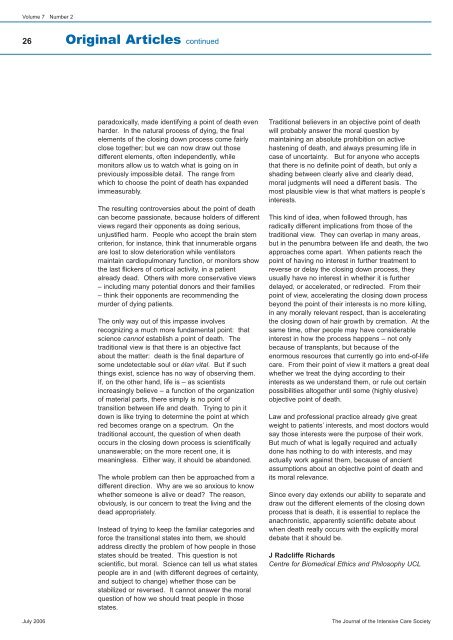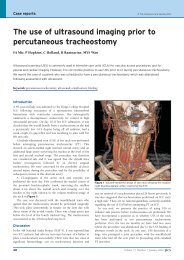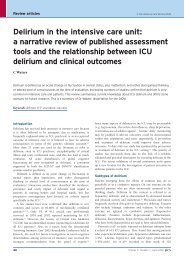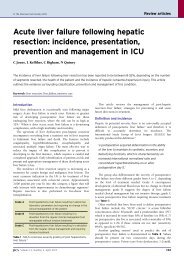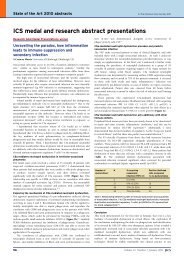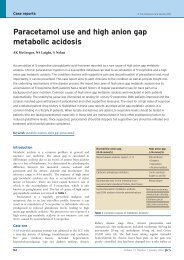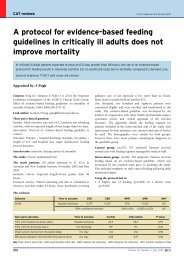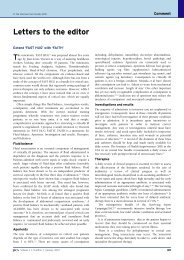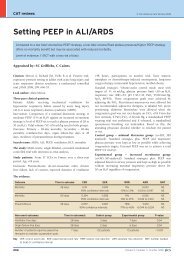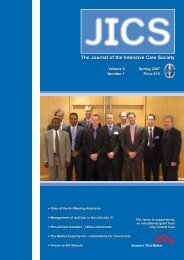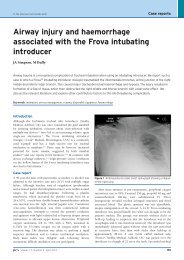Volume 7 Number 2 July 2006 - JICS - The Intensive Care Society
Volume 7 Number 2 July 2006 - JICS - The Intensive Care Society
Volume 7 Number 2 July 2006 - JICS - The Intensive Care Society
You also want an ePaper? Increase the reach of your titles
YUMPU automatically turns print PDFs into web optimized ePapers that Google loves.
<strong>Volume</strong> 7 <strong>Number</strong> 2<br />
26<br />
Original Articles continued<br />
paradoxically, made identifying a point of death even<br />
harder. In the natural process of dying, the final<br />
elements of the closing down process come fairly<br />
close together; but we can now draw out those<br />
different elements, often independently, while<br />
monitors allow us to watch what is going on in<br />
previously impossible detail. <strong>The</strong> range from<br />
which to choose the point of death has expanded<br />
immeasurably.<br />
<strong>The</strong> resulting controversies about the point of death<br />
can become passionate, because holders of different<br />
views regard their opponents as doing serious,<br />
unjustified harm. People who accept the brain stem<br />
criterion, for instance, think that innumerable organs<br />
are lost to slow deterioration while ventilators<br />
maintain cardiopulmonary function, or monitors show<br />
the last flickers of cortical activity, in a patient<br />
already dead. Others with more conservative views<br />
– including many potential donors and their families<br />
– think their opponents are recommending the<br />
murder of dying patients.<br />
<strong>The</strong> only way out of this impasse involves<br />
recognizing a much more fundamental point: that<br />
science cannot establish a point of death. <strong>The</strong><br />
traditional view is that there is an objective fact<br />
about the matter: death is the final departure of<br />
some undetectable soul or élan vital. But if such<br />
things exist, science has no way of observing them.<br />
If, on the other hand, life is – as scientists<br />
increasingly believe – a function of the organization<br />
of material parts, there simply is no point of<br />
transition between life and death. Trying to pin it<br />
down is like trying to determine the point at which<br />
red becomes orange on a spectrum. On the<br />
traditional account, the question of when death<br />
occurs in the closing down process is scientifically<br />
unanswerable; on the more recent one, it is<br />
meaningless. Either way, it should be abandoned.<br />
<strong>The</strong> whole problem can then be approached from a<br />
different direction. Why are we so anxious to know<br />
whether someone is alive or dead? <strong>The</strong> reason,<br />
obviously, is our concern to treat the living and the<br />
dead appropriately.<br />
Instead of trying to keep the familiar categories and<br />
force the transitional states into them, we should<br />
address directly the problem of how people in those<br />
states should be treated. This question is not<br />
scientific, but moral. Science can tell us what states<br />
people are in and (with different degrees of certainty,<br />
and subject to change) whether those can be<br />
stabilized or reversed. It cannot answer the moral<br />
question of how we should treat people in those<br />
states.<br />
Traditional believers in an objective point of death<br />
will probably answer the moral question by<br />
maintaining an absolute prohibition on active<br />
hastening of death, and always presuming life in<br />
case of uncertainty. But for anyone who accepts<br />
that there is no definite point of death, but only a<br />
shading between clearly alive and clearly dead,<br />
moral judgments will need a different basis. <strong>The</strong><br />
most plausible view is that what matters is people’s<br />
interests.<br />
This kind of idea, when followed through, has<br />
radically different implications from those of the<br />
traditional view. <strong>The</strong>y can overlap in many areas,<br />
but in the penumbra between life and death, the two<br />
approaches come apart. When patients reach the<br />
point of having no interest in further treatment to<br />
reverse or delay the closing down process, they<br />
usually have no interest in whether it is further<br />
delayed, or accelerated, or redirected. From their<br />
point of view, accelerating the closing down process<br />
beyond the point of their interests is no more killing,<br />
in any morally relevant respect, than is accelerating<br />
the closing down of hair growth by cremation. At the<br />
same time, other people may have considerable<br />
interest in how the process happens – not only<br />
because of transplants, but because of the<br />
enormous resources that currently go into end-of-life<br />
care. From their point of view it matters a great deal<br />
whether we treat the dying according to their<br />
interests as we understand them, or rule out certain<br />
possibilities altogether until some (highly elusive)<br />
objective point of death.<br />
Law and professional practice already give great<br />
weight to patients’ interests, and most doctors would<br />
say those interests were the purpose of their work.<br />
But much of what is legally required and actually<br />
done has nothing to do with interests, and may<br />
actually work against them, because of ancient<br />
assumptions about an objective point of death and<br />
its moral relevance.<br />
Since every day extends our ability to separate and<br />
draw out the different elements of the closing down<br />
process that is death, it is essential to replace the<br />
anachronistic, apparently scientific debate about<br />
when death really occurs with the explicitly moral<br />
debate that it should be.<br />
J Radcliffe Richards<br />
Centre for Biomedical Ethics and Philosophy UCL<br />
<strong>July</strong> <strong>2006</strong><br />
<strong>The</strong> Journal of the <strong>Intensive</strong> <strong>Care</strong> <strong>Society</strong>


